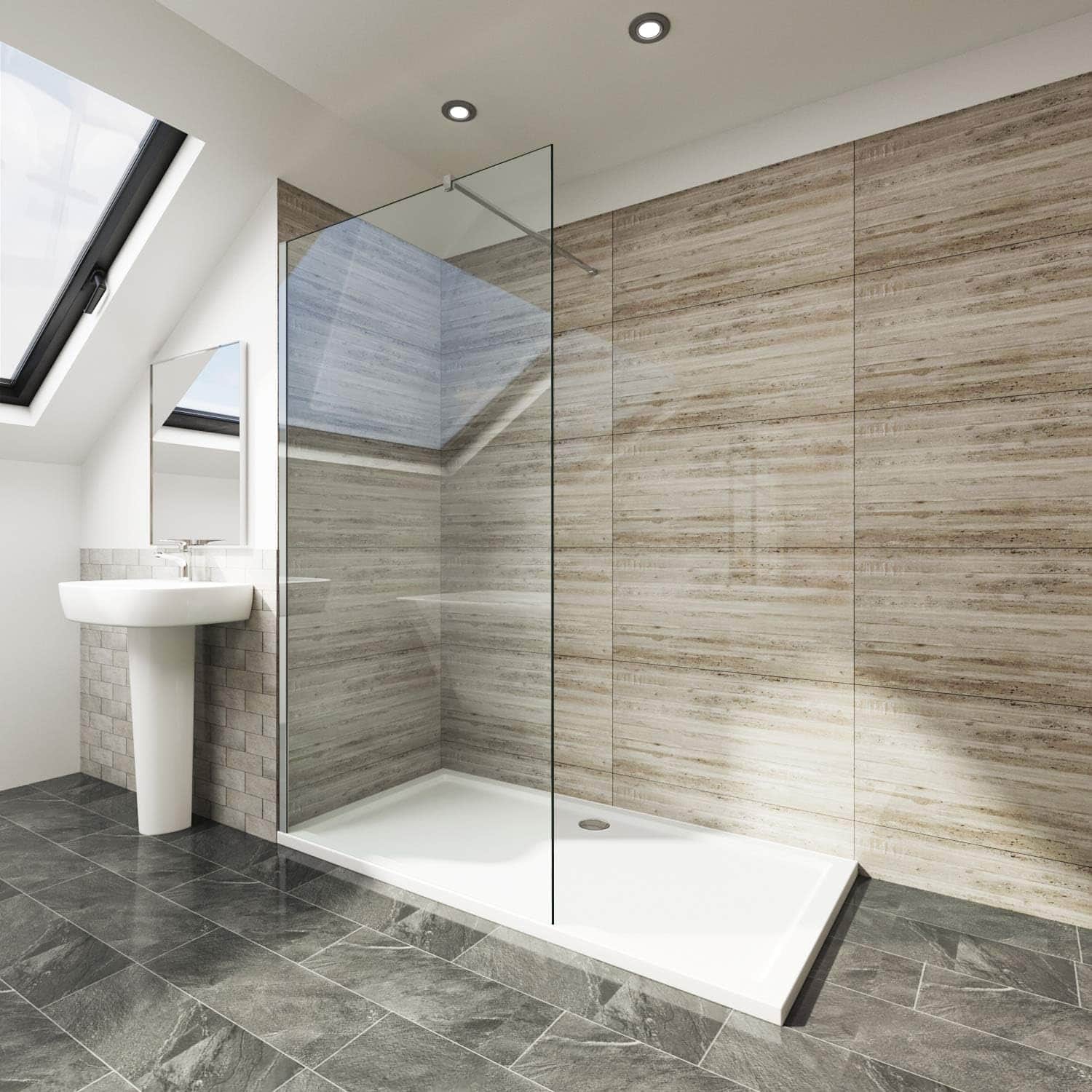Walk-in showers have become a staple in modern bathroom designs, as their easy access and sleek aesthetic appeal offers a refreshing twist to the traditional bathing experience.
They are particularly popular in the UK, with homeowners increasingly deciding to replace baths with walk-in showers to further efficiency and accessibility.
It is important to note that Walk-in showers are particularly suitable for the elderly, as they are designed with safety and comfort in mind. For those with limited mobility, this variety of shower is an exceptionally practical choice. This is because it caters to specific needs, with aspects such as wheelchair access and easy-to-use additional features.
A key feature of a walk-in shower for elderly people is the inclusion of grab bars, providing additional support and reducing the risk of dangerous slips and falls. It is important to note that grab bars are crucial to maintaining elderly’s people’s independence, as well as ensuring their safety when carrying out everyday tasks. Additionally, the potential to include a seat allows for a relaxing shower experience without the strain of standing.
A walk in shower for elderly people also features wide entry and exit points, designed to allow for carer access. This means that assistance can be provided when needed, without compromising the dignity or independence of the user.
Walk-in showers can also come with shower trays, this stable base further enhancing the safety of the shower. Therefore, it provides a safe and practical way for any potential carers to assist with bathing.
In terms of making efficient use of space, walk-in showers can be designed to fit into various sizes of bathroom. This guarantees that they can be accommodated by rooms with limited square footage. Moreover, no matter the size of the bathroom, a sense of light and spaciousness can be created through the glass panels that often come with these showers.




















Designing a walk-in shower requires a large amount of careful consideration. The overall bathroom space is an important factor to review, as walk-in showers can be tailored to fit into both smaller and larger spaces. This flexibility allows homeowners to create a showering experience to suit their individual and unique needs.
An option worth considering is a wet room shower. These are popular options due to their stylish and modern appearance, practical design, and simple cleaning process. These convenient showers usually feature a floor-level shower tray and a glass enclosure, consequently creating an airy space.
Coming in a range of shapes and sizes, glass enclosures both provide privacy and help to contain the water within the shower area. Additionally, the variety of enclosure designs means that homeowners can choose one which fits their bathroom layout, as well as their own personal style.
Another important consideration is the type of door. Whilst some people prefer a doorless design for easier access, others opt for a glass door for added privacy. Consequently, the choice of a door very much impacts the overall look and feel of the shower.
The benefits of walk-in showers extend beyond their stylish design. This is because they offer easy access, particularly beneficial for seniors or those with mobility issues. A walk-in shower also eliminates the need to step over a high bath edge, greatly reducing the risk of accidents.
A walk-in shower for elderly people also offer a spacious bathing experience, the lack of constraints of a bath allowing users to move freely within the shower. For those who need to sit while showering or those requiring carer assistance, this can be particularly beneficial.
The easy cleaning nature of walk-in showers, with their simple design and minimal fixtures, also make them less likely to accumulate dirt. This is a huge benefit, meaning that less time is subsequently spent on maintenance.
Lastly, due to their modern design and high-quality materials, walk-ins add a touch of luxury to the bathroom. They have the capacity to transform a simple bathroom into a spa-like retreat, adding value to the home and enhancing your overall living experience.
The installation process for walk-in showers comprises of several steps. To begin with, the existing bath or shower enclosure is removed so that the shower tray and plumbing can be installed in the available space.
Next, tiling begins for the shower walls. This is followed by the installation of the shower enclosure, typically consisting of glass panels. If one is included in the design, this means that the door is installed after completion of the enclosure.
The final step in this process is the addition of any extra features mentioned above, such as grab bars or a shower seat. These extra components are specifically useful for those with limited mobility or for elderly users, providing additional support while showering.
Notably, the installation process can vary depending on the specific design of the walk-in shower. This is because some showers may require additional steps, such as the installation of a wet room screen or the application of waterproofing materials.
It is important to note that the maintenance involved with a walk-in shower’s upkeep is relatively straightforward. Regular cleaning is key, as the shower will be regularly wet and dirty.
This process involves wiping down the glass panels and shower tray. This prevents the build-up of any soap scum and limescale, which can create problems down the line. Furthermore, it is highly important that the shower tray is kept clean in order to prevent slips and falls. In regards to tiled walls, a mild cleaning solution is recommended to prevent damage to the grout.
In addition, the shower’s fixtures should also be regularly checked, including the door and any extra safety features. This ensures that these features are secure and properly functional.
Another consideration is the water drainage of the walk-in shower. Clearance of the drains should be carried out regularly to prevent blockages. This is not only ensuring efficient water flow, but also helps to prevent water damage and mould growth.
Switching a bath for a walk-in shower is a common home improvement project, since it offers a more accessible and modern bathing experience. Therefore, you may find yourself asking, how much does is a walk in shower? You should note that the cost to replace a bath with a walk-in shower varies depending on the complexity of the project and the materials used. However, the many benefits of a walk-in shower often outweigh the costs.
A more spacious and relaxing shower experience is a prominent advantage, as well as the value that a walk-in shower can add to a home. This is specifically relevant when adding a walk in shower for elderly people. The easy access and option of safety features also offer a safer and more comfortable bathing experience, in terms of mobility.
Whether you are looking to update your bathroom or need a more accessible shower solution, a walk-in shower could be the perfect choice. Therefore, the cost to replace a bath with a walk-in shower should be seen as an investment in safety and convenience. Although upfront costs may vary, the long-term benefits in terms of accessibility and ease of use make these showers a worthwhile consideration for replacement.
Shower enclosures are a crucial element of walk-in showers, providing both privacy and confining the water spray within a contained area. Consequently, this prevents dangerous slippage and water damage.
These enclosures are often built with sturdy and breakage-resistant safety glass panels. It is important to note that choosing a shower enclosure with safety glass is an important decision, providing peace of mind due to its durability.
There are various types of enclosures, ranging from round to corner installations. Consequently, there is an enclosure to suit every bathroom layout and personal preference. This is a vital element to consider, as design will influence the overall aesthetic and functionality of the shower.
Moreover, the cost of a shower enclosure is typically included in the overall walk-in shower prices. However, variations in design and material may influence the final cost. This makes it advisable to request a free brochure from suppliers to compare options and make a thoroughly informed decision.
Creating an open and airy shower experience, and even arguably transforming the bathroom into a spa-esque space, wet rooms are a luxurious alternative to traditional shower enclosures.
Their design allows for the entire bathroom space to be waterproofed, meaning that the shower area does not have to be confined to an enclosed cubicle. By the resultant seamless look, an appearance of spaciousness can be created in the bathroom. Particularly when paired with practical wetroom screens, the panels of safety glass are installed to protect the rest of the bathroom from water spray.
Although he cost of installing a wet room shower can be slightly higher due to the additional waterproofing required, the numerous benefits and added value to the property can make this a worthy investment.
The choice of the tiling and lighting in a walk-in shower is also essential, as these decisions can greatly influence the atmosphere of the space. For instance, warm tiling tones and soft lighting create a relaxing environment which is ideal for unwinding after an arduous day.
Tiling is not only a practical choice for waterproofing the shower area, it also acts as an opportunity to add style and personality. Whether the aim is to achieve a traditional or a modern effect, there are many possible design options. These range from sleek subway tiles to textured stone effects.
Choosing bathroom-rated lights is crucial, working to ensure safety while showering. Lighting also plays a vital role in enhancing the shower experience through a design aspect. Whilst ceiling lights creating a clean and minimalist look, wall lights can add a touch of luxury.
The installation of tiling and lighting should be carried out by a professional, guaranteeing a high-quality finish. Consequently, these elements can significantly impact the overall look and feel of the walk-in shower.
Mobility showers are designed to cater to those with limited mobility, allowing the shower experience to become more accessible and comfortable. These showers typically feature a walk-in design, specific safety features, and a seat option.
There are many mobility-related benefits offered by these showers, as the easy-access design reduces the risk of accidents. Furthermore, the inclusion of safety features provides extra support and stability. They can also be customised to include assisted bathing options, allowing for carer access.
Although the cost of walk-in shower installations designed for mobility can vary, the advantages provided in terms of safety and ease of access make them a worthwhile investment. It is necessary to compare walk-in shower prices, allowing a budget-friendly solution to be identified.
The cost to replace a bath with a walk-in shower can vary as it is based on factors such as the size of the shower, the materials used, and the necessity for any structural changes to the bathroom. On average, the expected rate is between £1,000 to £3,000. However, these prices can rise when more luxurious designs or complex installations are involved. Furthermore, it is important to note that while there is an upfront cost, a walk-in shower can add value to your home and improve the quality of life. This is particularly relevant for individuals with mobility issues.
Creating a relaxing atmosphere in your walk-in shower can be achieved through the careful selection of lighting and fixtures. Consequently opting for warm, soft lighting will help to create a calming mood. Alternatively, choosing a shower head with different spray settings can even allow you to customise your shower experience. The incorporation of elements, such as a built-in seat or a steam feature, provides further opportunity to relax.
Standing in a walk-in shower is usually no more difficult than standing in a traditional shower or bath. Rather, many people find it easier because of the lack of a need to step over a high edge on entrance.
For those who have difficulty standing for long periods of time, many walk-in showers come with built-in seats or benches. This offers further relaxation during your shower.
The complexity of a walk-in shower installation can depend on several factors. This includes the size and design of the shower, the current layout of the bathroom in question, and whether plumbing changes are required. Generally, it is recommended for a professional to handle the installation. This will guarantee that everything is completed correctly and to a safe standard. Some companies even offer a thorough service, handling everything from the removal of your old bath to the installation of the new shower.
Based on the specific features included, assisted bathing prices for walk-in showers can vary widely. Cost can be influenced by extra features often seen in showers designed for assisted bathing, such as grab bars, non-slip flooring, handheld shower heads, and sometimes even a built-in seat. This is in addition to the size and style of the shower. On average, you are expected to spend between £2,000 and £5,000 for a walk-in shower designed for assisted bathing. Before making a decision, it is crucial to get several quotes and consider your specific needs.
UK Care Guide is really proud to have been featured on some of the UK’s leading websites.

















Rachel is one of our fantastic writer’s, with a background in finance, complemented by her expertise in content creation.
Her strong financial acumen and knowledge, combined with a deep appreciation for art and humanities, gives her work a distinct edge, producing content that is both informative and insightful. With her broad-ranging experience, Rachel stands as an invaluable asset and writing compelling narratives.
